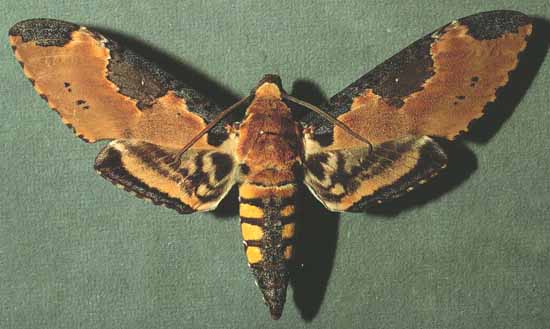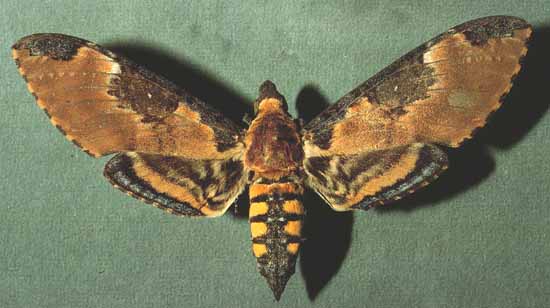Manduca ochus
Klug (1836)

Manduca ochus male courtesy of Dan Janzen.
This site has been created by
Bill Oehlke at oehlkew@islandtelecom.com
Comments, suggestions and/or additional information are welcomed by Bill.
TAXONOMY:
Family: Sphingidae, Latreille, 1802
Subfamily: Sphinginae, Latreille, [1802]
Tribe: Sphingini, Latreille, 1802
Genus: Manduca Hubner, 1807 ...........
Species: ochus Klug, 1836
|
MIDI MUSIC
.....It's a Wonderful World.....
copyright C. Odenkirk
ON.OFF
<bgsound src="world.mid" LOOP=FOREVER>
|
DISTRIBUTION:
Manduca ochus
(Wing span: (119 - 120 mm)),
flies in
Mexico, the specimen type locality;
Belize: Cayo;
Nicaragua: Jinotega, Granada, probably Rivas and elsewhere;
to Venezuela; and
Ecuador??
The adult cannot be confused with any other sphingid that occurs in
Costa Rica: Guanacaste, Puntarenas, Lemon,
Heredia, owing to the very distinctive pattern on the front wings.
In Costa Rica, adults of M. ochus are known from all kinds of
habitats below about 700 m elevation, but they are always at
extremely low density at lights.
FLIGHT TIMES:
In Costa Rica there are probably two or three generations annually with moths on the wing in all months except
the driest, February-March and July.
ECLOSION:
Pupae probably wiggle to surface from subterranean chambers just prior to eclosion.

Manduca ochus female courtesy of Dan Janzen.
SCENTING AND MATING:
Females call in the males with a pheromone released from a gland at the tip of
the abdomen. Adults nectar at flowers.
EGGS, LARVAE, PUPAE:
Larvae probably feed on plants in the nightshade family (Solanaceae).
Return to Sphingidae Index
Return to Sphingini Tribe
Use your browser "Back" button to return to the previous page.
This page is brought to you by
Bill Oehlke and the
WLSS. Pages are on space rented from Bizland. If you would like
to become a "Patron of the Sphingidae Site", contact Bill.
Please send sightings/images to Bill. I will do my best to respond to
requests for identification help.
Enjoy one of nature's wonderments: Live
Saturniidae (Giant Silkmoth) cocoons.
 | 
Show appreciation for this site by clicking on flashing butterfly to the left.
The link will take you to a page with links to many insect sites. |



